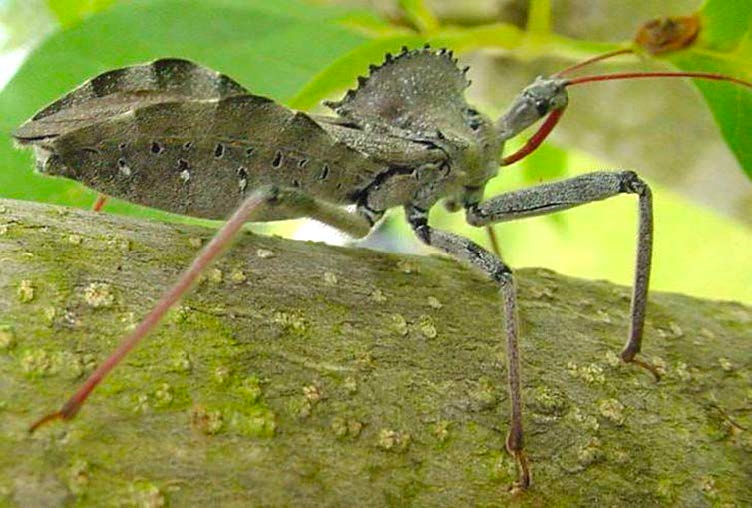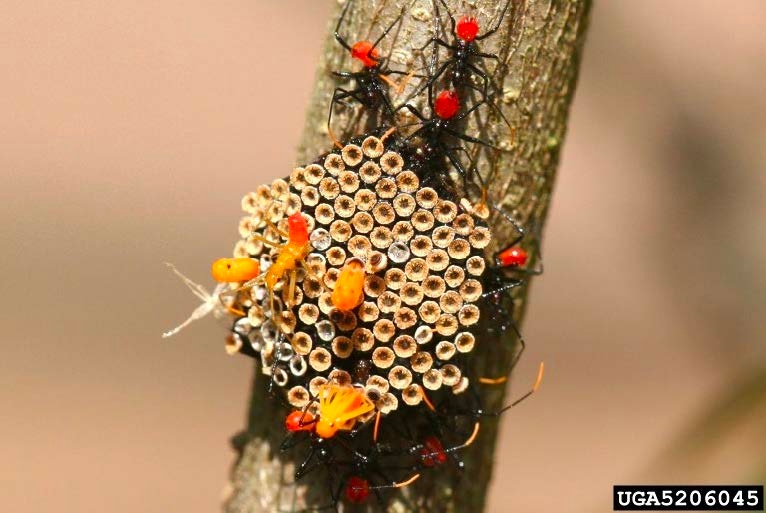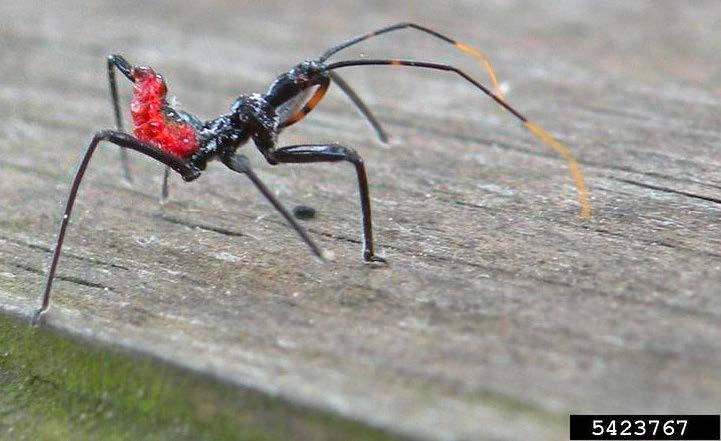Wheel Bug
ID
3104-1585 (ENTO-458NP)
Introduction
The wheel bug (Arilus cristatus) is one of the largest members of the family of insects known as assassin bugs (Hemiptera: Reduviidae). Most members of Reduviidae are predacious on other insects and the wheel bug is no exception. It spears its prey with its sharp beak and ingests the victim's body fluids.
Description
The alarming appearance of the wheel bug makes it a “monster” of the insect world. The large adult is grayish-black and measures about 2.5 cm (1 inch) long (Fig. 1). It has a distinctive semi-circular crest behind the head that resembles half of a cogwheel (thus the name “wheel bug”). The long, slender antennae, prominent beak, and lower ends of the long legs are reddish brown. The head is very narrow and slightly constricted behind the eyes, forming a tapered "neck." The rigid, segmented beak bends under the front of the head and down towards the legs. The abdomen is broad and flattened with alternating dark and light bands along the flared edge.

Wheel bug nymphs are much smaller than the adults and lack the cogwheel crest. The nymphs are bright orange when they first emerge from the eggs, but soon change color (Fig. 2). The front half of their body turns dark, but the abdomen remains a bright reddish-orange with dark markings (Figs. 2 & 3). The abdomens of young nymphs curve upward until the nymphs mature (Fig. 3).


Habitat
Wheel bugs can be found where their prey is abundant, such as among flowers, in gardens, or in fields and woods. Homeowners often discover slow-moving adult wheel bugs on the screens of windows and door, or on porches and decks.
Life Cycle
Wheel bugs have a life cycle of egg, nymphal, and adult stages. They overwinter as barrel-shaped eggs cemented together in masses of 10-40 eggs, somewhat resembling a honeycomb pattern (Fig. 2). Eggs hatch in May and June, and the nymphs soon begin hunting for prey. Caterpillars and other soft-bodied insects are among their favorite meals. They molt several times and grow in size through the season. By late summer they are adults, ready to mate and lay eggs on twigs and branches of trees. The wheel bug is most commonly noticed in late summer and early fall when the large adults are found. The adults die with cold weather and there is one generation per year.
Distribution
Wheel bugs are common in Virginia and can be found throughout much of the United States.
Damage
Although an adult wheel bug can give a painful bite if handled, wheel bugs are considered beneficial insects because they feed on many pest insects. They are not pests of plants. They are sometimes mistaken for “kissing bugs,” but wheel bugs do not feed on mammalian blood.
Control
Wheel bugs are beneficial insects and should be considered valuable allies. It’s best to learn to recognize them and leave them alone whenever possible. A fly swatter can be used for wheel bugs found near entries or where children might play. Wheel bugs do not feed on plants and it’s not necessary to spray them when they are found on plants.
Revised
Theresa A. Dellinger, September 24, 2021.
Virginia Cooperative Extension materials are available for public use, reprint, or citation without further permission, provided the use includes credit to the author and to Virginia Cooperative Extension, Virginia Tech, and Virginia State University.
Virginia Cooperative Extension is a partnership of Virginia Tech, Virginia State University, the U.S. Department of Agriculture (USDA), and local governments, and is an equal opportunity employer. For the full non-discrimination statement, please visit ext.vt.edu/accessibility.
Publication Date
September 29, 2021



